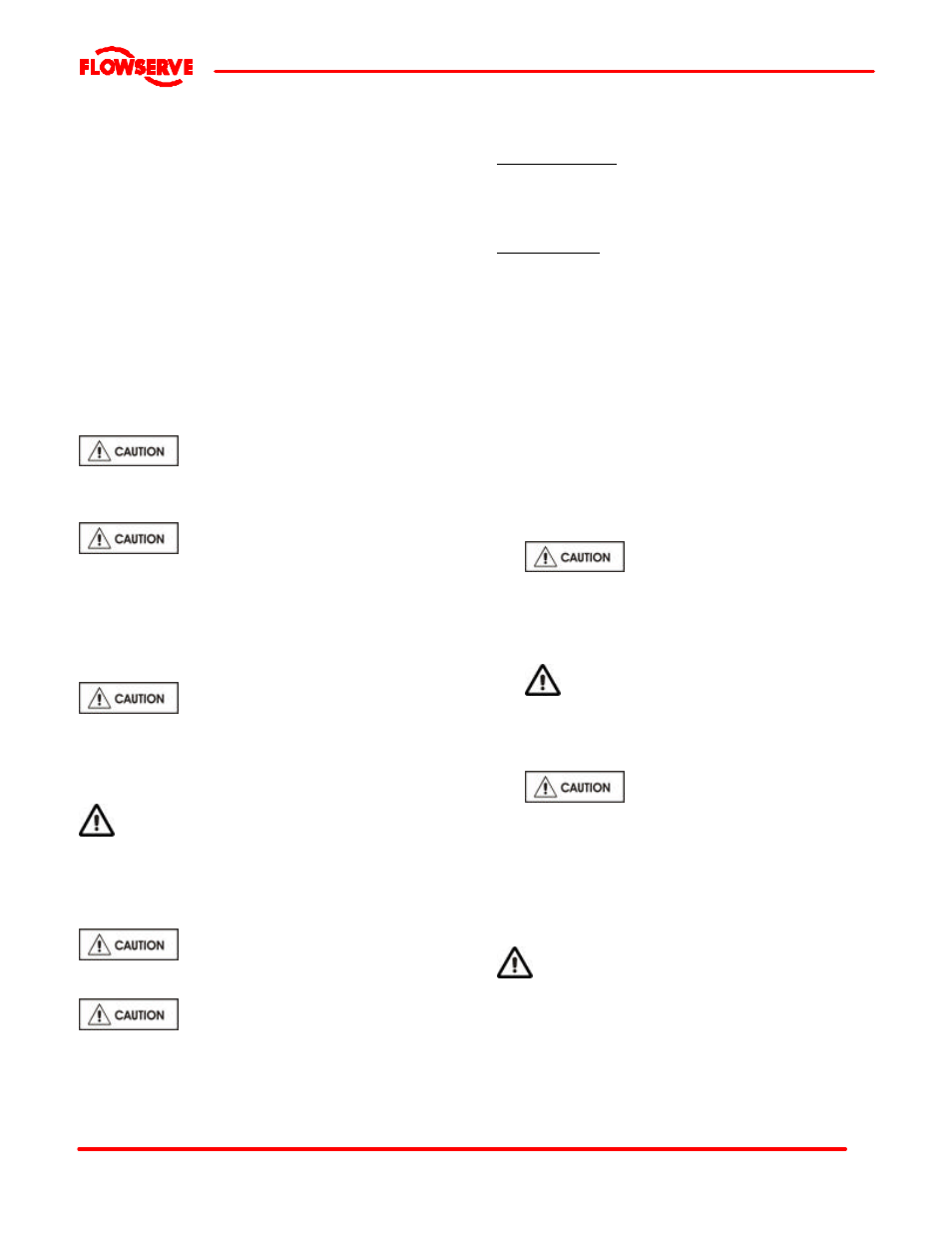Flowserve FRBH User Manual
Page 29

FRBH, FRBHX AND FRBHS USER INSTRUCTIONS ENGLISH 71569178 10-04
Page 29 of 54
®
5.2.4.2 Grease lubricated bearings
When grease nipples are fitted, one charge between
grease changes is advisable for most operating
conditions, ie 2 000 hours interval.
Normal intervals between grease changes are 4 000
hours or at least every 6 months.
The characteristics of the installation and severity of
service will determine the frequency of lubrication.
Lubricant and bearing temperature analysis can be
useful in optimising lubricant change intervals.
The bearing temperature may be allowed to rise to
55 ºC (131 ºF) above ambient but should not exceed 95
°
C (204
°
F). For most operating conditions a quality
grease having a lithium soap base and NLGI
consistency of No 2 or No 3 is recommended. The drop
point should exceed 175 ºC (350 ºF).
Never mix greases containing different
bases, thickeners or additives.
5.3 Direction of rotation
Ensure the pump is given the same
rotation as the pump direction arrow cast on the pump
casing. Rotation is clockwise when the pump is
viewed from the driver.
To avoid dry running the pump must either be filled
with liquid or have the flexible coupling disconnected
before driver is switched on.
If maintenance work has been carried
out to the site's electricity supply, the direction of
rotation should be re-checked as above in case the
supply phasing has been altered.
5.4 Guarding
Guarding is supplied fitted to the pump set. If
this has been removed or disturbed ensure that all the
protective guards around the pump coupling and
exposed parts of the shaft are securely fixed.
5.5 Priming and auxiliary supplies
Ensure all electrical, hydraulic,
pneumatic, sealant and lubrication systems (as
applicable) are connected and operational.
Ensure the inlet pipe and pump casing
are completely full of liquid before starting continuous
duty operation.
5.5.1 Suction pressure above atmospheric
pressure
Horizontal pumps: open vent connection [102.11] on
top of the pump upper casing to allow the trapped air
to escape. Let liquid run out until free from air
bubbles.
Vertical pumps: open vent connection [102.11] at the
front of the upper half casing and disconnect the seal
flush line at the mechanical seal/stuffing box to allow
the trapped air to escape. Let liquid run out until free
from air bubbles.
5.5.2 Suction lift with foot valve fitted
Fill suction pipe and casing with liquid at a pressure of
1 to 2 bar from an external source. Vent as described
in section 5.5.1.
5.5.3 Suction lift without foot valve
Pump casing vents on the suction volute must be
connected to an external vacuum pump priming
system. If in doubt please consult Flowserve.
5.6 Starting the pump
a)
Ensure flushing and/or cooling/
heating liquid supplies are turned ON before
starting the pump.
b) CLOSE the outlet valve.
c) OPEN all inlet valves.
d) Prime the pump.
e)
Ensure all vent connections are closed
before starting.
f) Start motor and check outlet pressure.
g) If the pressure is satisfactory, slowly OPEN outlet
control valve.
h)
Do not run the pump with the outlet
valve closed for a period longer than 30 seconds.
i)
If NO pressure, or LOW pressure, STOP the
pump. Refer to section 7, Faults; causes and
remedies, for fault diagnosis.
5.7 Running the pump
5.7.1 Venting the pump
Vent the pump to enable all trapped air to
escape taking due care with hot or hazardous liquids.
Under normal operating conditions, after the pump has
been fully primed and vented, it should be
unnecessary to re-vent the pump.
